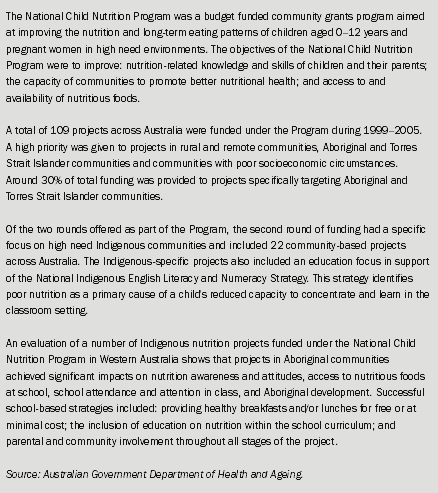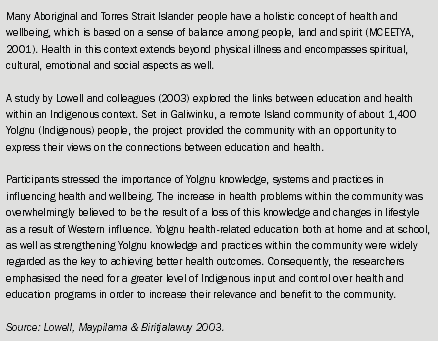International research has clearly established that higher levels of educational attainment are associated with better health outcomes. Strong positive correlations have been found between parental education, particularly that of the mother, and child health (Ewald & Boughton 2002). For example, studies on health transition in developing countries have shown that with the addition of one extra year of parental schooling, the infant mortality rate drops between 7% and 10%. There is also evidence of a clear relationship between an adult's level of education and their risk of heart disease, stroke and diet-related illnesses (MCEETYA 2001).
There has been little investigation, however, into how educational attainment affects health in the Indigenous population (Boughton 2000; Lowell, Maypilama & Biritjalawuy 2003). The few statistically based studies that have been undertaken in Australia do not point to a straightforward association between schooling and Indigenous health (Gray & Boughton 2001).
The ways in which health affects Indigenous educational attainment, however, have received more attention. A child's health has a powerful impact on whether or not they attend school and on their ability to learn and participate in school activities (MCEETYA 2001). The National Indigenous English Literacy and Numeracy Strategy (NIELNS) recognises the importance of improving the health of Indigenous children in order to enable them to increase their educational participation and attainment and consequently, their opportunities for a prosperous and healthy lifestyle (DEST 2000). The following discussion focuses on the two health conditions commonly identified as being the most detrimental to Indigenous educational outcomes: hearing loss and poor nutrition (SEWRSBEC 2000).
Hearing loss
Aboriginal and Torres Strait Islander school students are much more likely than their non-Indigenous peers to experience ear disease and hearing problems. There is a high rate of otitis media (middle ear infection) among Indigenous children, particularly in remote areas (DEST 2000). The prevalence of otitis media has been found to range from 40% to 70% in Indigenous communities compared with only 5% in more advantaged populations around the world (McRae et al. 2000). In Western Australia, the rates of otitis media among Aboriginal children aged 5-9 months has been found to be as high as 72% (Zubrick et al. 2004).
Chronic suppurative otitis media (CSOM) or 'runny ears' is the chronic condition that results from recurrent episodes of otitis media. It is typically characterised by a ruptured eardrum and discharge from the middle ear, which causes fluctuating and sometimes permanent hearing loss, as well as other complications associated with infection (NACCHO 2003a). The World Health Organization (2003) recognises that a prevalence of CSOM greater than 4% in a given population is indicative of a major public health problem. In Australia, CSOM can affect up to 40% or more of Indigenous children living in remote areas (NACCHO 2003a). For more information on ear and hearing problems in the Indigenous population, refer to chapters 5 and 7 in this report.
Hearing loss as a result of CSOM has been associated with poor school achievement for Indigenous students (McRae et al. 2000). Indigenous children who are unable to hear correctly in the classroom are placed at a significant disadvantage, particularly in reading and language acquisition. These problems are magnified for those students learning English as a second language (Collins 1999; McRae et al. 2000). However, there remains a lack of solid quantitative evidence to show the effects of this condition on Indigenous educational outcomes (Mellor & Corrigan 2004).
There is evidence to suggest that Indigenous children with CSOM attend school less frequently than other children. The National Aboriginal Community Controlled Health Organisation's (NACCHO) Ear Trial and School Attendance Project found that during the trial period, children with CSOM attended school only 69% of the days available compared with 88% of other children in the same schools (NACCHO 2003b). Furthermore, a study in the Northern Territory showed that Indigenous children who had low attendance rates were more likely than those with high attendance rates to have ear disease and associated hearing loss (Collins 1999).
Common school-based strategies to help prevent and combat the effects of ear disease include regular health screenings and ear examinations in schools, as well as installing amplification systems in classrooms to create an enhanced listening environment (Collins 1999). Access to salt water or chlorinated swimming pools (due to the anti-bacterial properties of salt water and chlorine) also helps reduce the number of ear infections among Indigenous children (Lehmann 2003).
Poor nutrition
Poor nutrition is another significant health issue affecting many Indigenous school students. Children who lack regular meals or have inadequate access to fresh, nutritious food tend to be tired, underweight and prone to other illnesses (SEWRSBEC 2000). Reports by the Northern Territory Health Services show that 13% to 22% of Indigenous children aged five years or younger in non-urban areas of the Northern Territory are clinically underweight (Collins 1999). Moreover, school screening in the Northern Territory in 1993 revealed that 39% of Indigenous children living in remote communities were anaemic and 22% were malnourished (Paterson, Ruben & Nossar 1998).
Poor nutrition severely limits a child's capacity to concentrate and learn at school. Children with poor diets are often lethargic or disruptive in the classroom and are more likely to be absent from school (SEWRSBEC 2000). In recognition of this issue, NIELNS emphasises the value of school-based nutrition programs in improving school performance and attendance. As well as distributing healthy meals to students at school, these programs provide an opportunity to convey health and nutrition information to the students and their families (see box 3.7). For more information on Indigenous nutrition, refer to Chapters 6 and 8 in this report.
3.7 The National Child Nutrition Program

Health and education correlations from the NATSISS
Results from the 2002 NATSISS show that education was positively correlated with self-assessed health status. Table 3.8 shows that Indigenous persons aged 18-34 years who had completed Year 12 were more likely than those who had left school at Year 9 or below to rate their health as excellent or very good (63% compared with 45%). They were also less likely to rate their health as fair or poor (9% compared with 16%). The causal pathways that underlie this interaction are complex and difficult to measure, therefore it is not known whether higher levels of educational attainment lead to better health, or better health leads to higher educational attainment.
There was also an association between highest level of schooling and whether a person had a disability or long-term health condition. About one-third (35%) of people aged 18-34 years who had left school at Year 9 or below had a disability in 2002, compared with 18% of those who had completed Year 12. Among the former group, the most common type of disability reported was a physical disability, followed by a sight, hearing or speech disability. However, because the NATSISS did not collect information about the age of disability onset, it is not known whether the person's disability was present while they were at school or whether it occurred later in life.
Finally, the likelihood of engaging in health risk behaviours decreased with higher levels of schooling. While this was particularly evident for smoking, there was only a marginal decline in the proportion of people aged 18-34 years who consumed alcohol at risky or high risk levels with each additional year of school completed (table 3.8).
A similar pattern of association between higher educational attainment and improved health outcomes can be observed for Indigenous people aged 35 years or over. Age is also a contributing factor in this case, as the relatively small proportion of people aged 35 years or over who have completed school to Year 12 (11%) were younger (median age 41 years) than those who had not progressed to this level of schooling (median age 47 years).
3.8 Health characteristics of Indigenous persons, by highest year of school completed(a) - 2002 |
|  |
 |  |  | 18-34 years | 35 years or over |  |
 |  |  | Year 9 or below(b) | Year 10/11 | Year 12 | Year 9 or below(b) | Year 10/11 | Year 12 |  |
|  |
| Self-assessed health status(c) |  |  |  |  |  |  |  |  |
 | Excellent/very good | % | 44.5 | 51.1 | 62.7 | 23.5 | 41.4 | 42.4 |  |
 | Fair/poor | % | 15.8 | 13.9 | 9.1 | 45.4 | 26.0 | 25.8 |  |
| Has a disability or long-term health condition | % | 34.6 | 26.4 | 18.2 | 59.0 | 39.2 | 32.5 |  |
| Risk/behaviour characteristics |  |  |  |  |  |  |  |  |
 | Current daily smoker | % | 69.8 | 55.7 | 38.5 | 48.3 | 48.5 | 41.9 |  |
 | Risky/high risk alcohol consumption in last 12 months | % | 17.5 | 15.5 | 13.9 | 17.7 | 17.5 | 14.6 |  |
| Indigenous persons | no. | 30 700 | 58 600 | 32 400 | 71 400 | 43 200 | 13 700 |  |
|  |
| (a) Excludes persons still at secondary school. |
| (b) Includes persons who never attended school. |
| (c) 'Good' category not shown. |
| ABS, 2002 NATSISS |
3.9 The links between education and health in Galiwinku

 Print Page
Print Page
 Print All
Print All